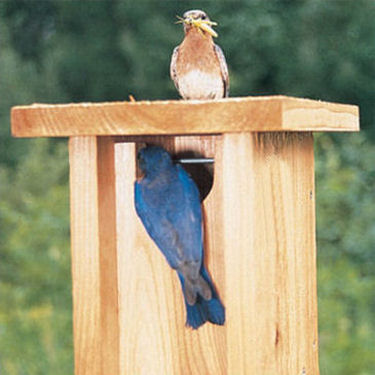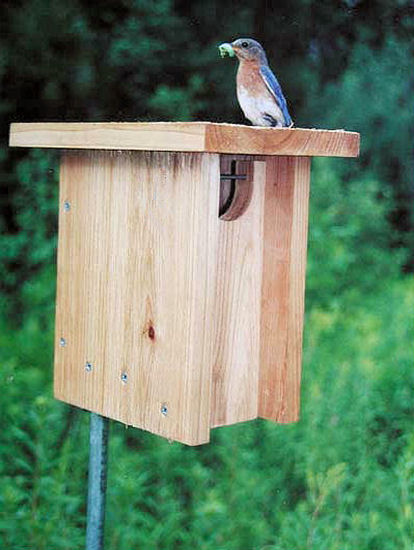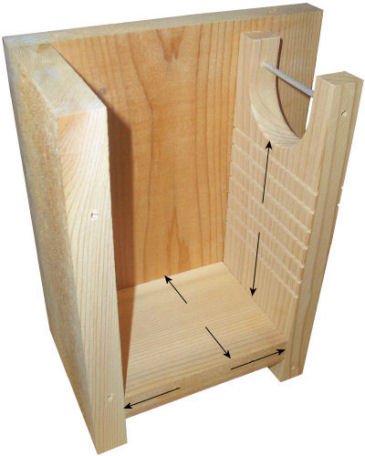
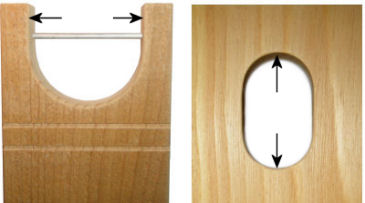

The Gilwood Nestbox
by Fred Stille and Steve Gilbertson
by Fred Stille and Steve Gilbertson
Home | Site Map | Disclaimer | Contact Us
Copyright © 2012 NestboxBuilder.com
This site was last updated on 11/01/2020
Copyright © 2012 NestboxBuilder.com
This site was last updated on 11/01/2020
The Gilwood represented one of the most radical changes in bluebird nestbox design since manmade nesting structures were first erected for Eastern Bluebirds in the 1930s. Designed by Steve Gilbertson of Aitkin MN, the Gilwood has since established itself as a favorite with both Bluebirders and the Bluebirds themselves.
What's the magic? Well, Bluebirds certainly don't approach the nestbox and say "Hey, it's a Gilwood," (although sometimes we think they might). So why is this nestbox so desirable to Bluebirds? To find the answer, I decided to ask the Gilwood's designer.
What's the magic? Well, Bluebirds certainly don't approach the nestbox and say "Hey, it's a Gilwood," (although sometimes we think they might). So why is this nestbox so desirable to Bluebirds? To find the answer, I decided to ask the Gilwood's designer.
Q: What makes one nestbox more desirable to birds than another?
Steve: Nestboxes have four features in common: an entry of some size and shape; a certain distance from the bottom of that entry to the floor; the cavity size; and the ambient light level inside the box. Birds pay a lot of attention to these four elements when selecting a nestbox. The key is to refine each of those features to suit what the bird wants, then design those preferences into the nestbox.
Q: How did you identify these preferences?
Steve: In areas where natural cavities are scarce, competition for nesting sites can be fierce. In this case, preferences are hard to detect, as the birds will nest in whatever cavities are available. But if the birds have the luxury of making a choice, they will reveal these preferences. Pairing boxes on my trails, with variations in the four key elements, eventually showed me what the birds preferred.
Steve: Bluebirds, especially Eastern Bluebirds, like a large entry. Dick Peterson's trail research proved that when given a choice, Bluebirds preferred his 2 1/4" x 1 3/8" oval entry over the standard round.
In studying Bluebird anatomy, I felt they might prefer a wider entrance, so I began by turning the Peterson oval horizontally. I extended this 2 1/4" width to the top of the door, which then resembled an inverted mouse-hole.
To discourage avian predators from reaching inside the nestbox, I knew I had to close down the height of the mouse-hole to between 1 1/4" and 1 3/8", but I did not want to block the excellent ventilation the overall entry size would provide. A simple 1/8" diameter wire solved the problem. Threaded through both of the sides and across the inverted mouse-hole, it reduced the functional height of the entry without blocking airflow, and served as the door pivot as well. The Gilwood entrance was born.
Q: Could a different style entry be used on the Gilwood, say a 1 1/2" or 1 9/16" round, or a Peterson oval?
Steve: Certainly. But these style entries won't provide the same ventilation of the Gilwood entry, so vent holes in the sides should be added to compensate.
Steve: The first step was to establish the Eastern Bluebird's preference. Again, this was determined by years of trail research conducted by Dick Peterson and myself, where we provided the birds with varying floor sizes to choose from. We discovered that the birds, when given the choice, were more inclined to choose a nestbox with a floor size of between fourteen and sixteen square inches.
A floor size in this range would serve another purpose: it deters the European Starling, a competitor species that prefers a much larger cavity. The Peterson nestbox has a nesting area of around fourteen square inches [at nest level], and starlings almost never attempt to nest in that box, even though they can squeeze through the Peterson oval entry.
I live-trapped Starlings and placed them in the Gilwood, where they always managed to escape. But the fifteen square inch floor would be a deterrent to them, as the Peterson nestbox had already proved.
Steve: We've learned that it's much better to prevent climbing predators from reaching the box in the first place, rather than depending on the box itself to provide protection. The 1/2" conduit pole does a good job in deterring climbing predators as long as it's polished and waxed. As far as predator birds reaching inside, the Gilwood entry, with its tight dimension beneath the wire, prevents that.
Dick Peterson and I discovered through pairing boxes on our trails, offering boxes of different depths, that the Eastern Bluebird showed a strong preference for a drop of around 5". I had no reason to argue with success, so that's the dimension I used for the Gilwood.
Steve: I'm convinced they do. When a bird perches half inside a round entry hole, their bodies effectively block all light that would normally come through that entry, and the box interior goes dark. Woodpeckers do not chisel out perfectly round holes, so these entrances don't block all light when the bird is perched there.
When first investigating a new cavity or nestbox, most Bluebirds don't immediately go inside. They remain in the entry and bob their head in and out a few times. Are they checking for danger inside the box? Would you poke your head into a dark hole without first allowing your eyes to adjust to the lower light level? It's much the same thing.
Of course ventilation holes or slots in the sides of some nestboxes, and slot entries, will maintain a certain light level inside the box even when the bird is perched in the entry. The Gilwood entry with its 4 square inches of area provides all the ventilation the box needs and, at the same time, allows light to enter the box above the birds body.
Q: Why did you design the Gilwood with a recessed door?
Steve: The total thickness of the back and door, plus the length of the floor, is around 6". A 1 x 6, which is actually 5 1/2", would not cover the door. The next standard size up, a 1 x 8, was too wide. Because I did not want to create a design that required cutting standard lumber to a non standard size, I left those 1 x 8s as is, which created a door recess of about 1 1/4".
Q: There are no floor drains on the Gilwood. Why not?
Steve: The Gilwood is a dry box. All of the openings - the entry and the gaps between the door and side panels - are facing the front, which should be faced away from prevailing winds. The recessed front protects it further from windswept rain. If any box takes on a large amount of water, the nest is going to get soaked regardless of whether the floor has drains.
I conducted an experiment where I filled the Gilwood with water from a hose, and all the water drained out quickly through the small door seams. Floor drains might speed this process slightly, but the nest would still be wet in any case. And floor drains, contrary to popular belief, do not help dry a soaking wet nest.
Q: So the appeal of the Gilwood to Bluebirds is the combination of their preferences designed into one box. What other features are important in a nestbox?
Steve: There are features the birds don't readily see, or see at all. It is our responsibility to keep the birds safe by designing and building a nestbox that is tight and dry, won't overheat and is easy to monitor. Mounting the nestbox properly and in good habitat is equally important as the nestbox itself. A successful nestbox is a mixture of all these things.
Steve: Nestboxes have four features in common: an entry of some size and shape; a certain distance from the bottom of that entry to the floor; the cavity size; and the ambient light level inside the box. Birds pay a lot of attention to these four elements when selecting a nestbox. The key is to refine each of those features to suit what the bird wants, then design those preferences into the nestbox.
Q: How did you identify these preferences?
Steve: In areas where natural cavities are scarce, competition for nesting sites can be fierce. In this case, preferences are hard to detect, as the birds will nest in whatever cavities are available. But if the birds have the luxury of making a choice, they will reveal these preferences. Pairing boxes on my trails, with variations in the four key elements, eventually showed me what the birds preferred.
Entry
Q: The Gilwood inverted mouse-hole entry was a radical change from the standard round entry that was prevalent at the time. What led you to this style entry?Steve: Bluebirds, especially Eastern Bluebirds, like a large entry. Dick Peterson's trail research proved that when given a choice, Bluebirds preferred his 2 1/4" x 1 3/8" oval entry over the standard round.
In studying Bluebird anatomy, I felt they might prefer a wider entrance, so I began by turning the Peterson oval horizontally. I extended this 2 1/4" width to the top of the door, which then resembled an inverted mouse-hole.
To discourage avian predators from reaching inside the nestbox, I knew I had to close down the height of the mouse-hole to between 1 1/4" and 1 3/8", but I did not want to block the excellent ventilation the overall entry size would provide. A simple 1/8" diameter wire solved the problem. Threaded through both of the sides and across the inverted mouse-hole, it reduced the functional height of the entry without blocking airflow, and served as the door pivot as well. The Gilwood entrance was born.
Q: Could a different style entry be used on the Gilwood, say a 1 1/2" or 1 9/16" round, or a Peterson oval?
Steve: Certainly. But these style entries won't provide the same ventilation of the Gilwood entry, so vent holes in the sides should be added to compensate.
Cavity Size
Q: How was the Gilwood's floor size determined?Steve: The first step was to establish the Eastern Bluebird's preference. Again, this was determined by years of trail research conducted by Dick Peterson and myself, where we provided the birds with varying floor sizes to choose from. We discovered that the birds, when given the choice, were more inclined to choose a nestbox with a floor size of between fourteen and sixteen square inches.
A floor size in this range would serve another purpose: it deters the European Starling, a competitor species that prefers a much larger cavity. The Peterson nestbox has a nesting area of around fourteen square inches [at nest level], and starlings almost never attempt to nest in that box, even though they can squeeze through the Peterson oval entry.
I live-trapped Starlings and placed them in the Gilwood, where they always managed to escape. But the fifteen square inch floor would be a deterrent to them, as the Peterson nestbox had already proved.
The "Drop"
Q: The distance from the bottom of the entry to the floor, or drop, is the subject of much debate. Many claim that a deeper box provides more protection from the probing arms of raccoons and cats, and prevents avian predators from reaching the nest inside. Others have discovered that the birds - especially Eastern Bluebirds - build a taller nest in a deep box, effectively canceling the deep box strategy. What are your thoughts on this?Steve: We've learned that it's much better to prevent climbing predators from reaching the box in the first place, rather than depending on the box itself to provide protection. The 1/2" conduit pole does a good job in deterring climbing predators as long as it's polished and waxed. As far as predator birds reaching inside, the Gilwood entry, with its tight dimension beneath the wire, prevents that.
Dick Peterson and I discovered through pairing boxes on our trails, offering boxes of different depths, that the Eastern Bluebird showed a strong preference for a drop of around 5". I had no reason to argue with success, so that's the dimension I used for the Gilwood.
Ambient Light
Q: You mentioned ambient light inside the box. Do birds really have a preference for this?Steve: I'm convinced they do. When a bird perches half inside a round entry hole, their bodies effectively block all light that would normally come through that entry, and the box interior goes dark. Woodpeckers do not chisel out perfectly round holes, so these entrances don't block all light when the bird is perched there.
When first investigating a new cavity or nestbox, most Bluebirds don't immediately go inside. They remain in the entry and bob their head in and out a few times. Are they checking for danger inside the box? Would you poke your head into a dark hole without first allowing your eyes to adjust to the lower light level? It's much the same thing.
Of course ventilation holes or slots in the sides of some nestboxes, and slot entries, will maintain a certain light level inside the box even when the bird is perched in the entry. The Gilwood entry with its 4 square inches of area provides all the ventilation the box needs and, at the same time, allows light to enter the box above the birds body.
Q: Why did you design the Gilwood with a recessed door?
Steve: The total thickness of the back and door, plus the length of the floor, is around 6". A 1 x 6, which is actually 5 1/2", would not cover the door. The next standard size up, a 1 x 8, was too wide. Because I did not want to create a design that required cutting standard lumber to a non standard size, I left those 1 x 8s as is, which created a door recess of about 1 1/4".
Q: There are no floor drains on the Gilwood. Why not?
Steve: The Gilwood is a dry box. All of the openings - the entry and the gaps between the door and side panels - are facing the front, which should be faced away from prevailing winds. The recessed front protects it further from windswept rain. If any box takes on a large amount of water, the nest is going to get soaked regardless of whether the floor has drains.
I conducted an experiment where I filled the Gilwood with water from a hose, and all the water drained out quickly through the small door seams. Floor drains might speed this process slightly, but the nest would still be wet in any case. And floor drains, contrary to popular belief, do not help dry a soaking wet nest.
Q: So the appeal of the Gilwood to Bluebirds is the combination of their preferences designed into one box. What other features are important in a nestbox?
Steve: There are features the birds don't readily see, or see at all. It is our responsibility to keep the birds safe by designing and building a nestbox that is tight and dry, won't overheat and is easy to monitor. Mounting the nestbox properly and in good habitat is equally important as the nestbox itself. A successful nestbox is a mixture of all these things.
3 1/2"
4 1/4"
With a floor area of approximately 15 square inches and a drop of 5", the Gilwood's cavity has proved attractive to Eastern Bluebirds.
Eastern Bluebirds have displayed a preference for large entries, such as the Gilwood (above left) and the Peterson oval (above right)
Anatomy of a Nestbox Design
Q&A with
Steve Gilbertson
Q&A with
Steve Gilbertson
5"
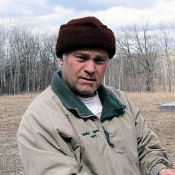
The Gilwood's entry wire reduces the functional height of the entry to exclude larger birds.
2 1/4"
2 1/4"
The Gilwood can also be built as a slot box. Plans are available on the Plans Page.
Steve's contributions to Bluebird recovery cannot be overstated. His designs include the Gilbertson PVC nestbox (above left), the Universal Sparrow Trap (above right), a mealworm feeder and the 1/2" conduit/rebar mounting system.
"I'm enjoying retirement," Steve says. Here he's about to try his luck on Lake Sisabagamah near his home in Aitkin, MN.
photo by Tom Comfort
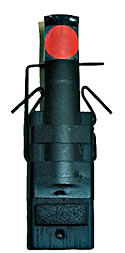
Gilwood # 1: Steve's first Gilwood.
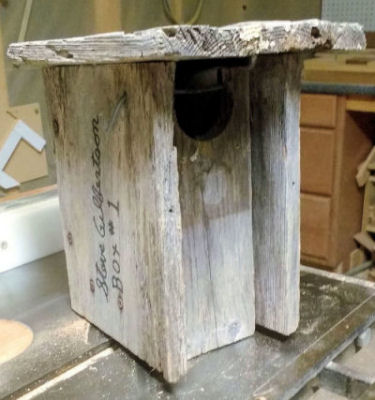
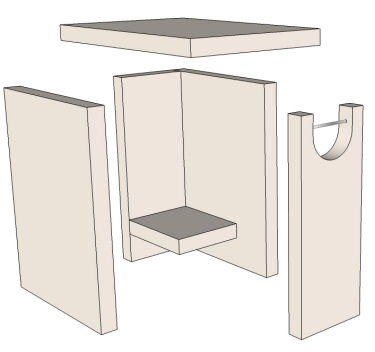


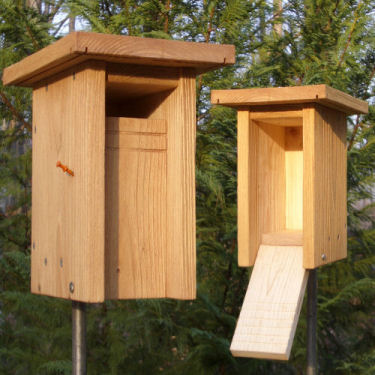
The Gilwood is simple to build using stock lumber sizes.
